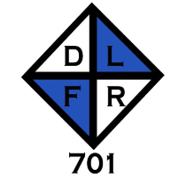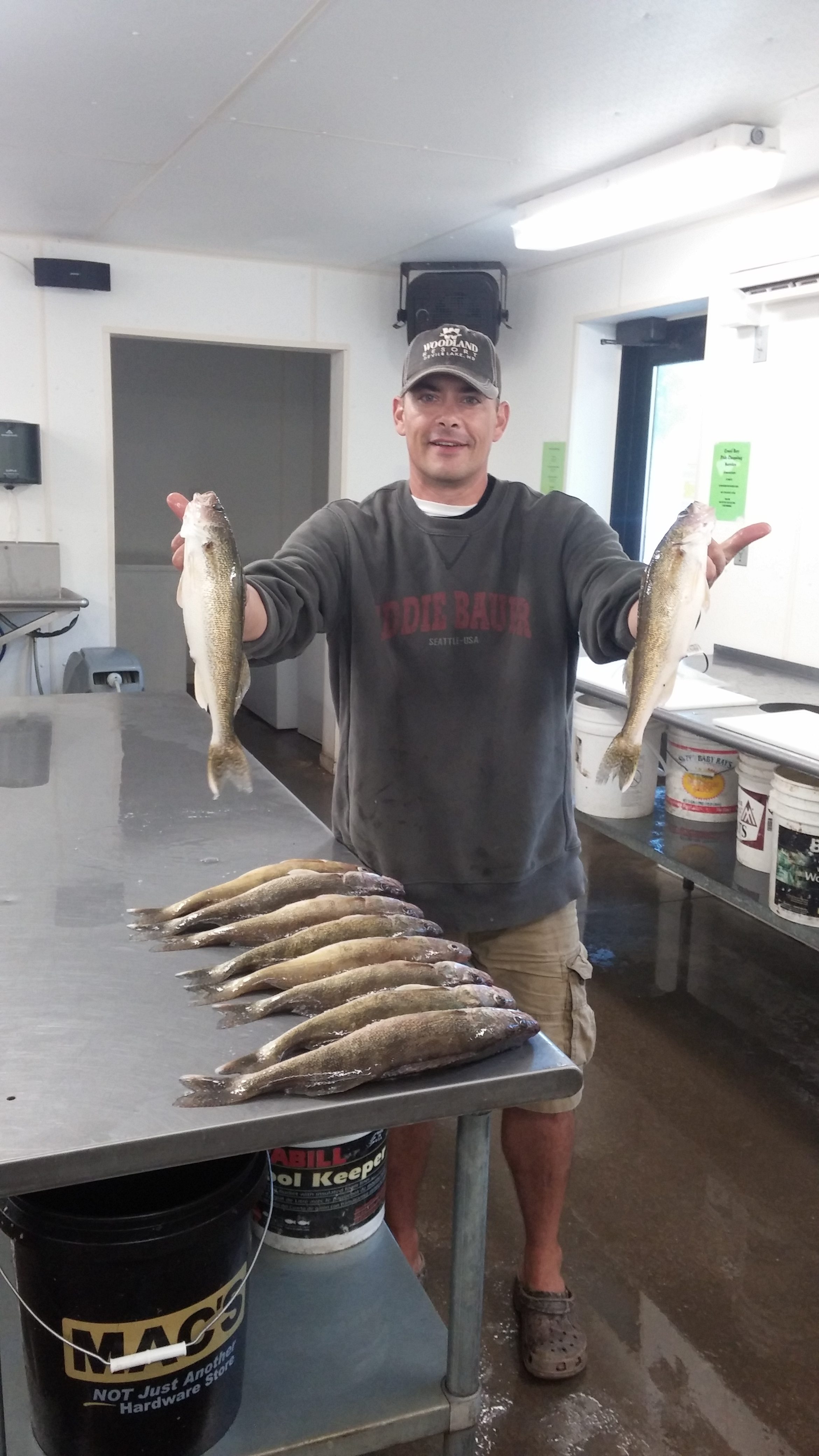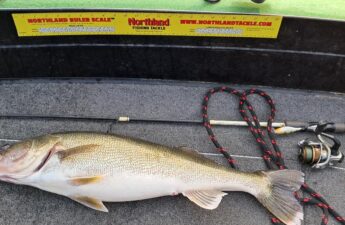Devils Lake Fishing Report #13
Early Morning Sandwich Eye Troll
I have expressed my belief that it is important to get on the Lake early, like really early, like sun not up yet early. This was the case this last Sunday; we were loaded and on the water as the sun was peaking over the horizon. The weather forecast was a little ‘off’ as usual and we had to adjust our original target area.
We decided to focus on 3 ledges at 3 different water depths to search for some deeper water walleyes and possibly check for Perch schools. We would be protected from the wind and the troll line was about a mile and a half stretch where we hoped to lay down some troll line waypoints.
We were not disappointed. From our starting point, the eater-sized walleyes were more than happy to make our plans successful. The ledge we found most of the keeper sized Walleyes on, was in the 24-28 foot range.
It is one of the old shoreline ledges that often attracts schooled up fish. A lot of the bites were very subtle and rod holders were not used, we had to have rods in hand and hook ups required giving the fish the spinner as we felt them suck it in. There were also schools of immature white bass that were acting as bait thieves.
We didn’t even make one complete pass to our pre-determined turn point before we had boated our limit of 10 Sandwich Eyes. The ledge we were trolling was in 24-28 feet of water, 2-ounce bottom bouncers, ¼ night crawler and silver and gold spinners were the ticket.
The MYDLNDWaypoints Factor
We had success on a troll line that we had established years ago. We knew there would be fish there, just had to find out if they were the right fish. We didn’t find that “Jumbo Perch Mega School” but we did find a nice limit of Walleyes.
Here is where MYDLNDWaypoints and the www.devilslakefishingreport.com DIGITS VAULT (coming soon) can help you, the average fisherman. This is just an example of what we will provide you with so you can take cleaning station pics that live up to Devils Lake’s reputation as a world class fishery.
Buy the Waypoints from this Report
The Devils Lake Ledge
I talk about Devils Lake ledges a lot. These ledges hold a lot of fish. Some of them are pretty narrow while others are quite wide and form nice fish holding flats over steep drops. These are the spots that later in the summer and most of the winter, we target for Walleyes and Perch.
A Devils Lake chip is almost a must in order to stay on these fish holding spots. I would be lost with out my Lowrance GPS and chip.
Why these distinct ledges? Devils Lake is basically ringed with 3 of these ledges at 3 different water levels and therefore, 3 different water temperature zones. At different times in the year, each ledge will become a little more attractive to fish as the temperature rises and later in the fall as the temperature drops.
Knowing when to target each ledge level is vital to fishing success. As I will explain next, these ledges are old shorelines that were engulfed by rising water and have now become target Walleye and Perch ambush spots.

Devils Lake Explained
The Big Devil, there are many reasons why the waters of Devils Lake have earned that term, from the speed at which the waters can become giant waves when inclement weather hits the Big Devil to how it has swallowed up 1000’s of acres of land in the Northern Tier of North Dakota.
In 1991, Lake Irvine was a dry lakebed; the Fish and Wildlife service was creating duck nesting islands on the lakebed of Lake Alice. The main water of Devils Lake tipped the scales at approximately 41,000 acres and was salty brine that harbored fishable numbers of walleye, pike, perch, and white bass, but was far from the world-class fishery that it is today.
Many were concerned about the long-term survivability of the lake. Some on the East end contemplated the idea of cutting off water flow to preserve the East End. The Golden Highway was still a road leading to Minnewauken.
Then came the winter, spring, and summer of 1993 and the year of 1997. The floodgates opened and catastrophic flooding hit the Big Devil. People along the lake literally packed their bags and left, fleeing homes that were being swallowed up by the hour. Roads were flooded, farmland was lost, and everything around the lake was left to the rapidly rising water.
Devils Lake is a unique situation. It is what is referred to as a ‘closed basin’, much like the Great Salt Lake. There are 2 coulees that feed it with winter runoff and spring rains from as far north as the Canadian border. During the drought years of the 80’s, these coulee beds were dry and the waters of Devils Lake were receding. With the onslaught of a wet cycle that is still in play, these coulees filled and brought with them an influx of fresh water.
From 1993 to the present, Devils Lake has expanded from a Salt Brine slough to a fertile inland sea of over 250,000 acres. With the rising waters came rising hatch numbers. Fertile new waters where natural reproduction of all fish species exploded. Newly flooded, standing timber presented a virtual living nursery to Devils Lake’s primary forage, the freshwater shrimp.
With endless habitat and all you can eat seafood buffet, Pike, Walleye, and White Bass numbers quickly caught up to the size of the lake. Tying up to a tree and slip bobbering for Walleyes in amongst the flooded timber was the go to method and almost every tournament on the Big Devil was won in 2-5 feet of flooded timber with slip bobbers.
The epic perch numbers of the 1980’s have not fully returned, but they are on the comeback and starting to multiply filling in their place on the lake. In 2000, if you came in with 5 Perch, EVERYONE wanted to know where you got them. Today, on the ice, 5 perch is a pretty ho hum day.
Over time, those trees rotted and fell, presenting ever more fishable habitat. Most of that flooded timber is gone now, all’s that is left is logs on the bottom of the lake, and some are reappearing as the waters slowly recede. Flooded timber slip bobbers no longer rule the tournaments and many anglers have had to adjust their techniques.
Most notable of this change is that while many do still slip bobber and jig some sort of wooded bottom; pitching cranks, trolling, and snap jigging have become the nom de plume on Devils Lake.
Machine Gun Perch
Summer on Devils Lake usually means targeting the mighty Walleye for most. I’m not most, once mid-July hits I almost exclusively chase Jumbo Perch, I’ll get my Walleye limit by accident, and often times they are big Walleyes because they are doing the same thing I am, going deeper, chasing the World Famous Devils Lake Jumbo Perch.
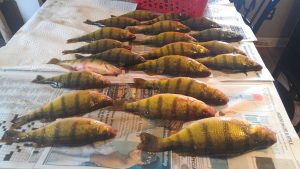
This endeavor requires a few necessities. It is almost exclusively a spinner game, and not your typical walleye #4 or #5 spinner. The weapon of choice for me is a #0 or #1 spinner trailed behind at least an ounce and a quarter bouncer and usually I will use a 2-ounce bottom bouncer. The presentation is slow, .5 to 1.2 miles per hour and lots of lazy Ivan’s, quick loops, and turns.
As you are exploring different depths and shelves you will suddenly hit schools of perch and your rod tip turns into a machine gun, Rat-at-at-at, that’s your indicator of a school, often times hook up success is very low, 10 to 1 at times. This is where the stinger hook comes in to play. Those perch are just attacking that back end of the worm and it is imperative to have that stinger hook buried in the very end of the worm.
If you have calm water, and I mean glass calm, once you locate these schools you can sit on them and use jigging and slip bobbers to get them. When we do this we use the lightest summer slip bobbers or ice buster bobbers that are normally used in the winter. You want as little resistance from the bobber as possible. For the jigging rods we will bust out our ice rods, as sensitive as possible and with as little resistance as possible. Calm evenings and a school of perch on Devils Lake can be exhilarating.
Employing the above tactics and finding these schools of Devils Lake gold can offer the King’s bounty like this:
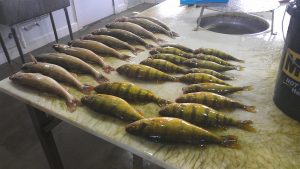
What’s for Lunch?
A lot of fisherman want to get their catch to the cleaning station and cleaned as soon as possible. For me, the data collection isn’t over yet. This can be a great opportunity to find out how you should be changing your presentation. When cleaning, cut open the guts, do a little investigation of what those Walleyes and Perch have been dining on.
Earlier this year we had ‘Gut Leeches”, this told us the leech was still king. A couple weeks later we found water beetles stuffed in their guts. This told us that the Walleyes were still up in the weeds. The contents of the stomachs of your catch can give you a plethora of information that can increase your success rate on your next trip.
Very soon on the Big Devil we are going to start to see frogs showing up in the stomachs of our bigger walleyes, this will be when it is time to go after those Tanker Devils Lake Eyes.
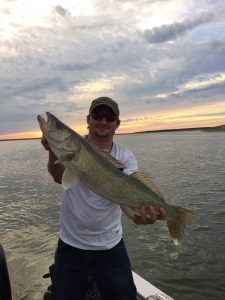
SPECIFIC BAYS and LOCALES: Attack the ledges, our focus right now is the 24-28 foot ledge, walleye and perch intermingled. Great spots are North Six Mile, Rocky Pt., Military shoreline on the main bay side, 5 crows, the parallel contours along patience pt. Extreme East Devils Lake, Black Tiger along the Woods-Rutten bridge corner. There are nice Walleyes on the highway 57 and 20 riprap from 9 feet all the way out to 25 feet. For bigger fish, it is still a snap jigging game on any rocky structure, Rocky Pt., any Power line Pylon, Lost Jig, Byrd Island.
If you want to Perch Search find deep ledges and sunken tree lines, There is a great one north of the Pepsi Sign in North Six Mile, it is an ‘Oh crap’ corner though, if you get into the trees, its “OH crap”, if you keep parallel it can be game on.
Devils Lake Fishing Report is published weekly with helpful tips and information for fishing Devils Lake and the Lake Region area.
